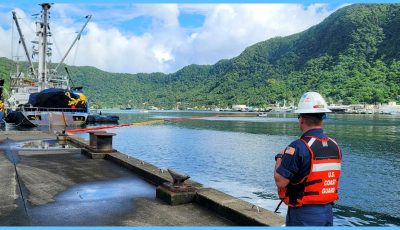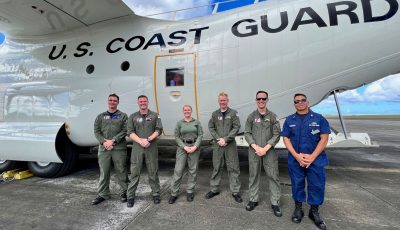Operation Blue Pacific: The US Coast Guard’s efforts to extend American influence
The U.S. Coast Guard has a strategic initiative dubbed “Operation Blue Pacific” that is ongoing and covers vast swaths of the planet, including our Deep Blue Pacific Ocean continent. One of the Coast Guard’s missions that gets much attention in our region of the world is the monitoring, ceasing, and prevention of illegal and unregulated fishing in select Pacific island nations’ exclusive economic zone areas.
The Coast Guard works with Pacific island nations such as New Zealand, Tonga, Fiji, Solomon Islands, Cook Islands, Naura, Kiribati, Samoa, Vanuatu, and Palau.
The Coast Guard transits throughout our Deep Blue Pacific Ocean continent using vessels called “cutters” that are more than 65 feet long. The Coast Guard has about nine formal missions that American taxpayers pay for and expect to be carried out from this organization. They include the following categories: search and rescue, drug interdiction, migrant interdiction, ports, waterways and coastal security, aids to navigation, protection of living marine resources, defense readiness operations and general law enforcement and ice operations.
In our region of the world, the Coast Guard is heavily involved in working with other Pacific island nation military and law enforcement personnel to train, advise, and build a common set of operating standards.
To date, it appears that the Coast Guard is doing an effective job.
For those not aware, the Coast Guard does not fall within the organizational confines of the Department of Defense because it is part of the Department of Homeland Security. The Coast Guard does, however, support and augment Pentagon-sponsored activities, especially in our region of the world. Today, our Mariana Islands fall under the Coast Guard’s District 14 area of responsibility.
The Coast Guard also does interesting and unique things such as mapping ocean floors, circumnavigational voyages, and ocean sampling and testing with both U.S. and international partners. The Coast Guard is well practiced in work that includes and involves humanitarian relief, medical evacuations, disaster response, pollution spills, navigation restoration, pollution prevention throughout the Pacific Ocean and beyond.
Questions Pacific Islanders should ask about the Coast Guard
Guam and the Northern Mariana Islands are smack in the middle of the ongoing arms race buildup being undertaken principally by the United States and China. Coast Guard personnel work hard and have many responsibilities to fulfill. It behooves our Chamorro Pacific Islanders to learn more about what precisely the Coast Guard does and understand what it does not do.
We are at a juncture where it is also important to ask questions of the Coast Guard because things are changing rapidly throughout our region of the world. So, for example, can the Coast Guard simultaneously respond and deal with an oil spill on Saipan, Tinian, and Guam with little notice? Does the Coast Guard do a robust job at recruiting and producing long-term career and growth opportunities for our Chamorro and Pacific Islander youth and adults? Does the Coast Guard have the necessary numbers of vessels to effectively and rapidly carry out its roles and responsibilities throughout our Marianas Islands region?
Are all shore-based infrastructure facilities owned by the Coast Guard fully capitalized, updated and ready for all contingency, surge, and all other required missions? Does the Coast Guard maintain deep and wide relationships with our people on an interisland basis and, if so, how can this organization improve on its existing suite of community-based programs?
What is the Coast Guard doing when it comes to purchasing and operationalizing unmanned boats and ships? Will an unmanned vessel mandate be particularly useful for the Coast Guard in our region or is it more important to stay focused on missions that require people 24/7?
Are the Guam and CNMI delegates aggressively ensuring that all Pacific Islanders who are able and interested in going to the Coast Guard Academy are able to readily compete with seats for each year’s class? Is enough being done to slot promising Pacific Islanders from our Mariana Island chain to apply for and get accepted into the one-year Coast Guard Preparatory School program? What is being done, if anything, to assist and encourage our young people who are excellent students at the University of Guam, Guam Community College, or Northern Marianas College who are interested in transferring into the Coast Guard Academy? If nothing is being done, why is this so?
The writer believes that the Coast Guard should be commended on the effectiveness of the work it does on an ongoing basis to save distressed swimmers, kayakers, boaters, and fishermen who for whatever reasons need assistance and are unable to safely return to shore.
The Coast Guard usually takes a back seat compared to the Pentagon when it comes to receiving major attention from the public. Let’s hope that our fellow Pacific Islanders remember and acknowledge the meaningful and purposeful work that the Coast Guard does because it is needed and necessary in our region of the world.
As an endnote, the Coast Guard just promoted for the first time ever a woman to lead the organization worldwide. Her name is Linda Fagan and she the first woman to become the commandant of the U.S. Coast Guard. Congratulations to the Coast Guard on this historic moment.



























